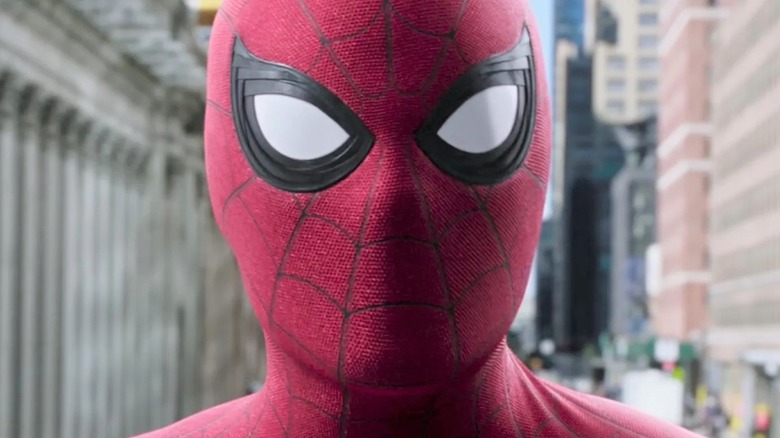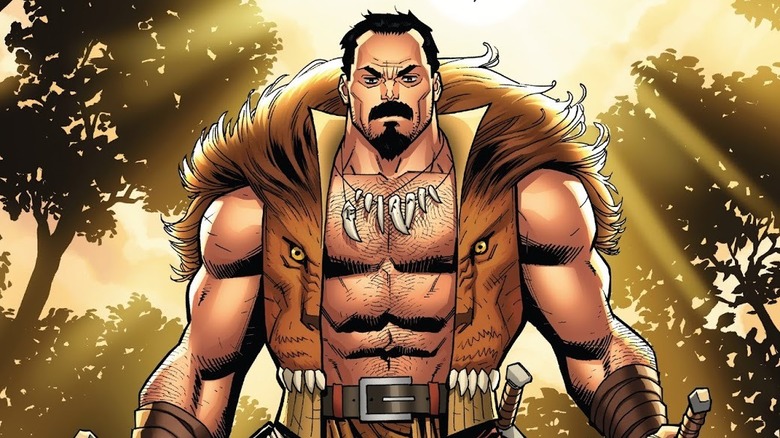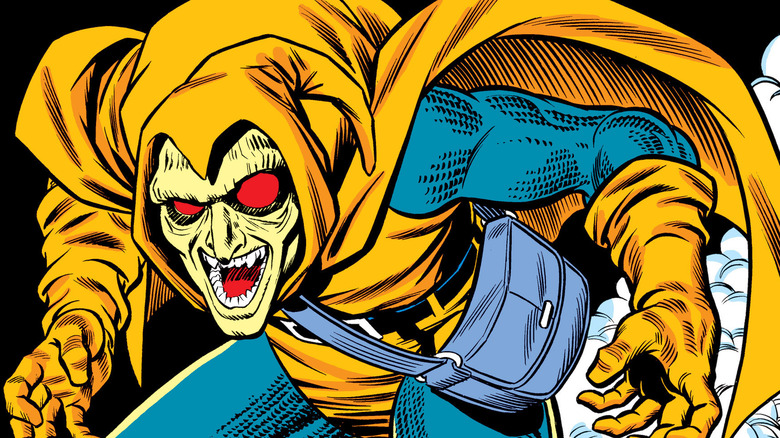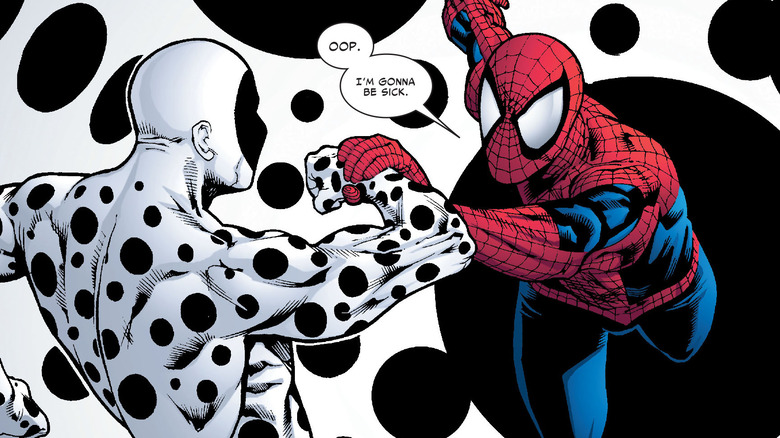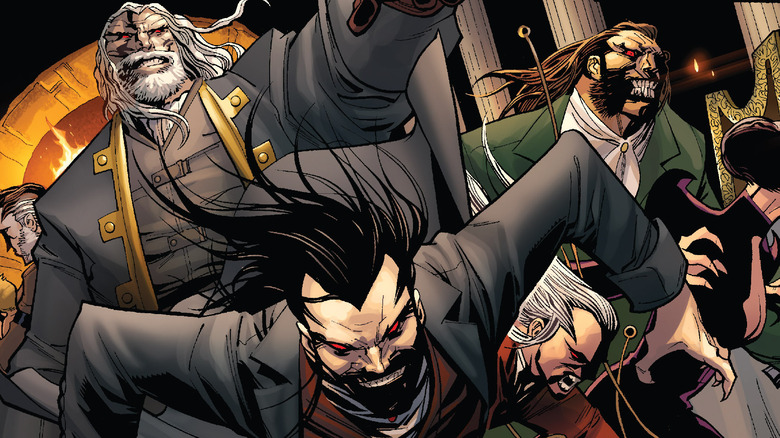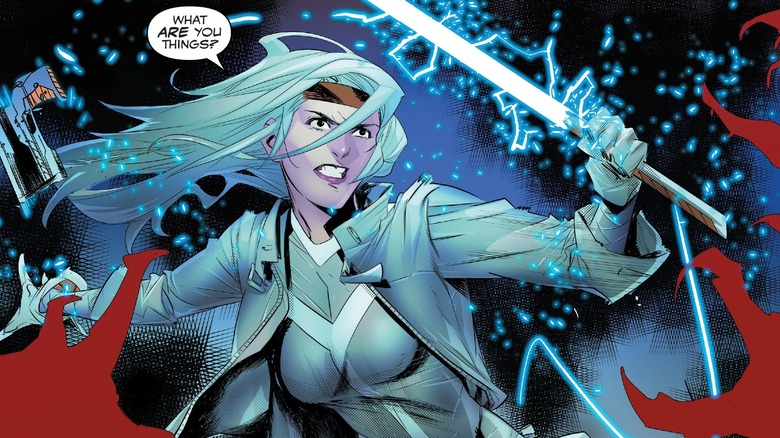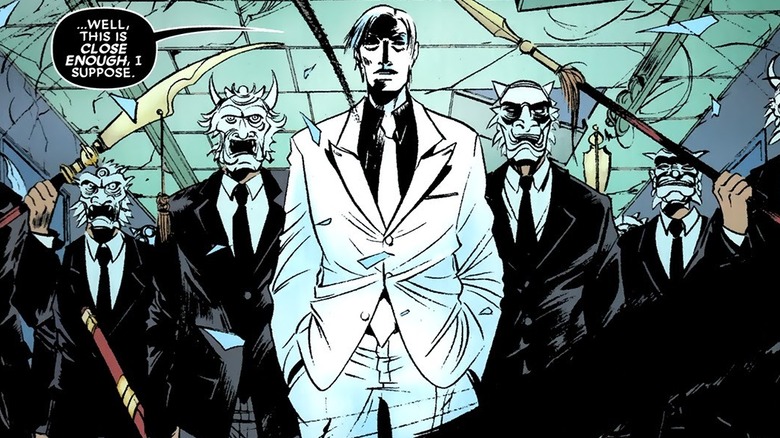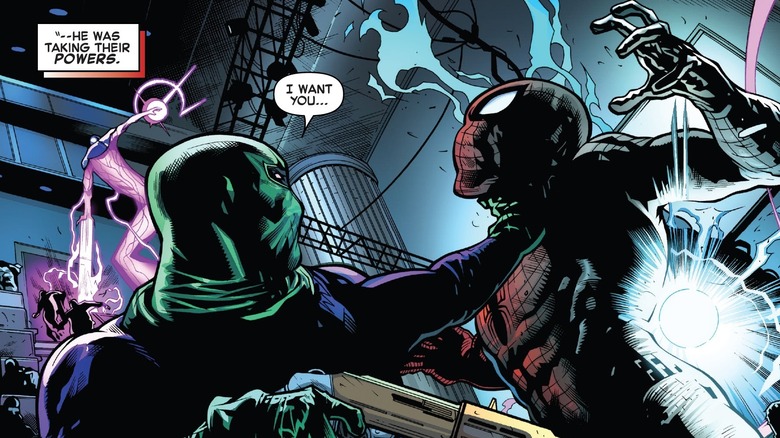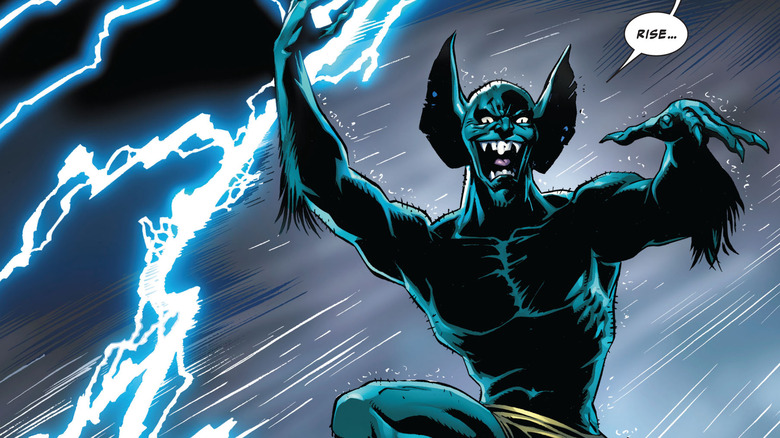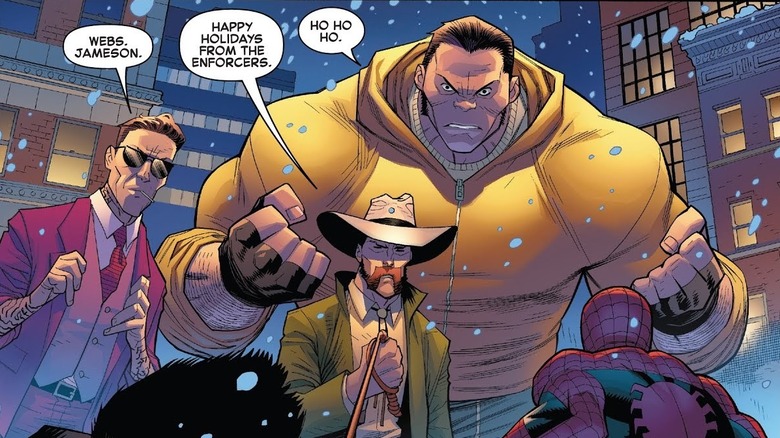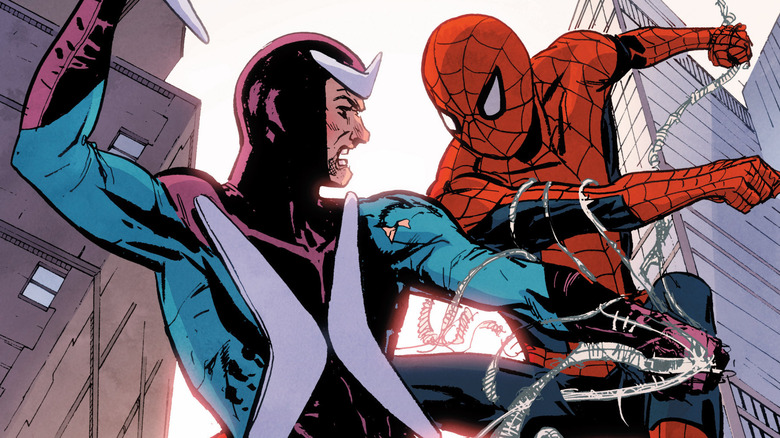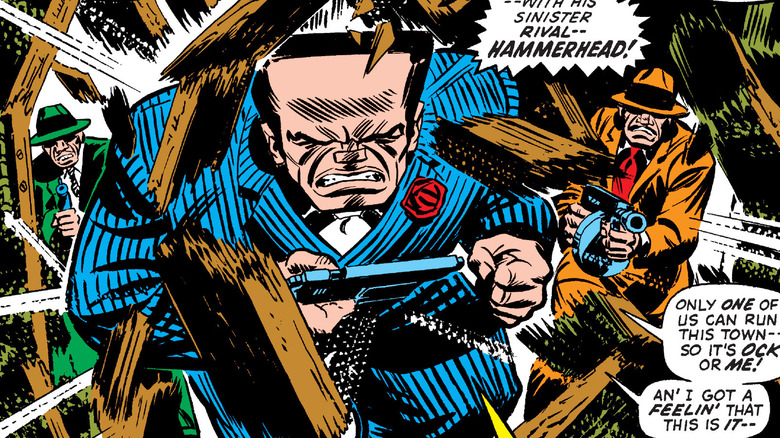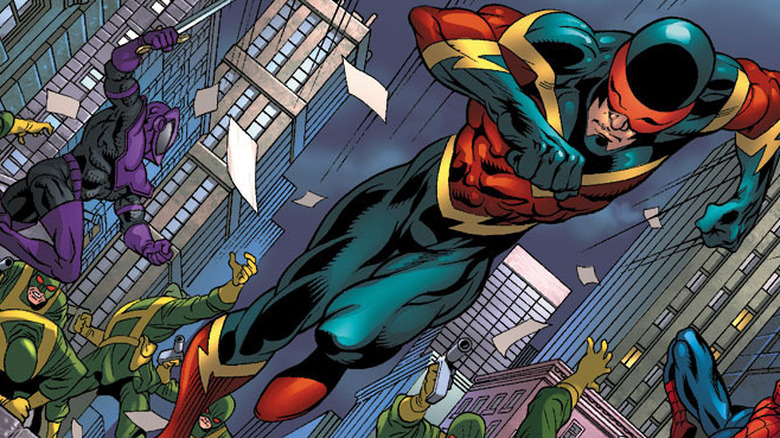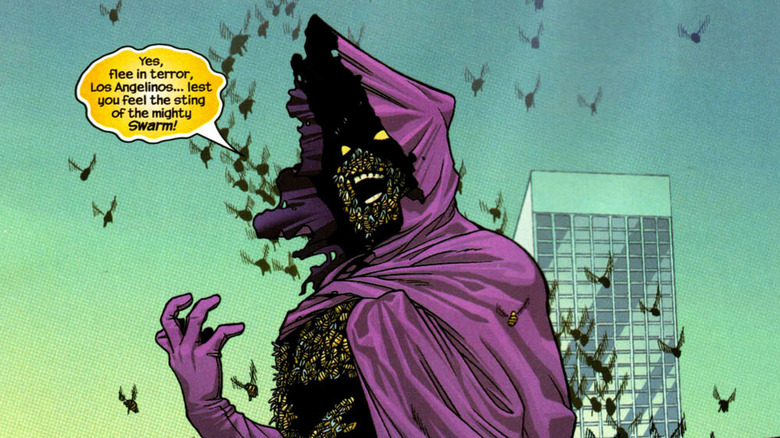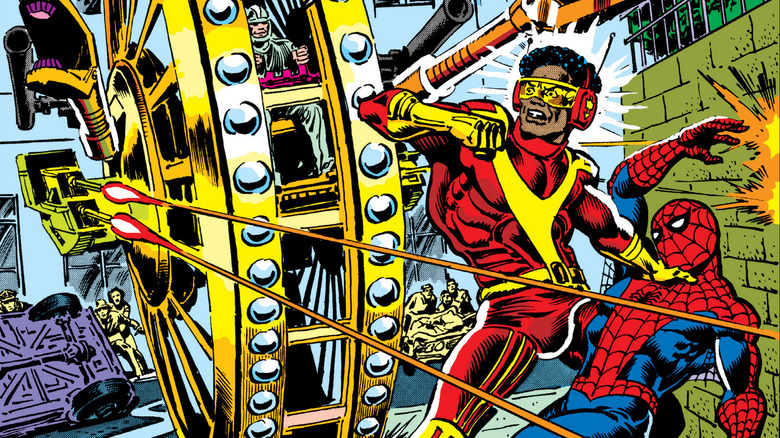14 Spider-Man Villains Who Have Yet To Appear On The Big Screen
Everyone knows that a "Spider-Man" movie is only as good as its villains, and there's a reason why Spidey's most beloved outings also feature his most compelling antagonists. From the Green Goblin and Doc Ock in Sam Raimi's first two flicks to Vulture and Mysterio in the MCU "Spider-Man" movies, it's clear that choosing the right opponent for the web-slinger can make a great film even better.
Equally, the less well-received "Spider-Man" films have been lambasted for their poor portrayal of the hero's villains, including "Spider-Man 3," which was famously criticized (even by Raimi himself) for being overstuffed with bad guys. Heck, one of the most exciting aspects of 2021's "Spider-Man: No Way Home" was its fresh take on the movies' inferior villains, such as Electro, Lizard, and Sandman.
In 2015, Forbes' Scott Mendelson argued that Spider-Man's rogues' gallery is one of the best in comic book history, and, honestly, it's hard to argue otherwise. Of course, by this point in Peter Parker's long Hollywood history, most of his truly iconic enemies have already shown up on-screen in some form or another — some more than once. There are, however, a few notable Spider-Man baddies who still haven't made their live-action movie debut. Here are 14 Spider-Man villains who've yet to appear on the big screen.
Warning — a few spoilers below.
Kraven the Hunter
Kraven the Hunter is by far the most infamous Spider-Man villain to have never featured in a live-action movie. Otherwise known as Sergei Kravinoff, this obsessive big-game hunter first appeared all the way back in 1964's "Amazing Spider-Man" Vol. 1 #15. In this story, Kraven is hired by his friend Chameleon (later revealed to be his half-brother) to bring down Spider-Man. Inevitably, the hunter quickly becomes the prey, and Spider-Man has Kraven hauled off to prison. This would mark the beginning of a long and storied criminal career for Sergei Kravinoff, who, in the comics, has devoted his entire existence to besting Spider-Man once and for all.
Considering Kraven is such a prominent member of Spider-Man's rogues' gallery, it'll come as no surprise to find that fans have been clamoring for him to show up on-screen for many years. And he's come pretty darn close, too — in 2021, Tom Holland even told Collider that "Spider-Man: No Way Home" director Jon Watts originally intended the third MCU Spidey movie to feature Kraven as the main antagonist.
Despite being set aside for "No Way Home" (well, unless that was indeed him peering through the multidimensional tear at the end of the film), it does seem like Kraven is about to be given his time in the spotlight. A solo film set within Sony's Spider-Man Universe has been on the cards for a while now, and, in 2021, Deadline reported that "Avengers: Age of Ultron" star Aaron Taylor-Johnson had been cast as the notorious hunter himself. Should all go to plan, "Kraven the Hunter" will land in theaters on January 13, 2023.
The Hobgoblin
Goblin villains will be very familiar to fans of the "Spider-Man" movies. Willem Dafoe made comic book history as Norman Osborn's Green Goblin in the original "Spider-Man" before returning for cameos in "Spider-Man 2" and "Spider-Man 3," as well as a more substantial role in "Spider-Man: No Way Home." Meanwhile, James Franco played Harry Osborn in Sam Raimi's trilogy, taking on the mantle of New Goblin in "Spider-Man 3." Similarly, Dane DeHaan played a Goblin-crazed Harry Osborn in "The Amazing Spider-Man 2."
In the comics, however, there are far more Goblins than the Green Goblin, and many more people have taken the mantle than Norman and Harry Osborn. Perhaps the second most well-known of these is the villain known as the Hobgoblin. Six people have operated under that name over the years, but the deadliest of all is Roderick Kingsley. Debuting as the masked villain in 1983's "The Amazing Spider-Man" Vol. 1 #238, Kingsley is a billionaire fashion designer who enters the criminal underworld after slightly altering Norman Osborn's Goblin formula. Kingsley's Hobgoblin has turned up over and over again since 1983, battling Osborn himself nearly as often as he does Peter Parker.
It's probably fair to say that audiences are kinda over the Green Goblin by now, despite Willem Dafoe's dramatic return in "No Way Home." Nevertheless, the Hobgoblin could offer a refreshing twist on a fan-favorite villain. Oh, and it's also worth pointing out that one character who used the Hobgoblin alias (albeit unwillingly) was none other than Ned Leeds. How about that for an MCU twist?
The Spot
Johnathon Ohnn, aka the Spot, first debuted in 1985's "Peter Parker, The Spectacular Spider-Man" Vol. 1 #98. A scientist in the employ of Kingpin, Ohnn creates a strange black portal while attempting to recreate the powers of the vigilante hero known as Cloak. After stepping through, Ohnn emerges in another dimension and soon discovers that he's gained the ability to open portals in order to traverse physical space via this so-called "Spotworld." Ohnn subsequently names himself the Spot (much to Spider-Man's amusement) and embarks upon a criminal career — one in which he's been killed and resurrected time after time.
The Spot's unique costume and strange abilities make him a more visually arresting villain than most, and suitably, he's featured in a number of stories beyond the comic book universe, including "Spider-Man: The Animated Series" and the 2017 "Spider-Man" series. It's possible he'll be popping up on the silver screen sometime soon too, as there have been reports that the Spot could be a "key baddie" in the upcoming animated sequel "Spider-Man: Across the Spider-Verse." Since the comic version of Ohnn is a close ally of Kingpin, who acted as the main antagonist in "Spider-Man: Into the Spider-Verse," it's easy to see how he might fit into Miles Morales' story ... and how the Spot's interdimensional powers could provide an intriguing slant on the original movie's multiverse antics.
The Inheritors
The Inheritors are a team of supervillains created for the original "Spider-Verse" story arc and its follow-up, "Spider-Geddon," having first appeared in "The Superior Spider-Man" Vol. 1 #33. Each member of this clan of totem-hunting vampires has dedicated their life to hunting down Spider-People across the multiverse and consuming their essences, using the powers of the reality-hopping Web of Life and Destiny in order to do so.
A number of Inheritors have battled Spider-Man and his allies, but the two most prominent are Morlun and Karn. The favorite son of the Inheritor patriarch Solus, Morlun is arguably the deadliest and scariest member of the Inheritors, having murdered and consumed a whole heap of Spider-People during his so-called "Great Hunt." Karn, meanwhile, is living in exile during his first appearance. He's distinct from his family in that he never enjoyed their endless hunt and only participated out of the need to survive. After Karn hesitated on a mission to capture the Master Weaver, who controls the Web of Life and Destiny, his mother — and the Inheritor matriarch — was killed. As a result, Karn was exiled until he could prove his return, a task he attempts to accomplish throughout the first "Spider-Verse" storyline.
As the main antagonists of the comic book version of "Spider-Verse," it seems odd that the Inheritors had nothing to do with "Spider-Man: Into the Spider-Verse." Still, with two follow-ups planned for that movie, who knows what the future has in store for these bitter enemies of Spider-Man and his many multiversal allies.
Silver Sable
Silver Sable is one of those Spider-Man characters who can act as an ally or an enemy of the wallcrawler, depending on what the story requires. Born Silvija Sablinova, this highly skilled mercenary was introduced in 1985's "Amazing Spider-Man" Vol. 1 #265, in which she led the vigilante team of soldiers known as the Wild Pack. Although she's collaborated with a number of superheroes over the years, including Spider-Man, Silver Sable has still played the role of antagonist every now and then. Some adaptations, such as the 2018 video game "Marvel's Spider-Man," even depict Sable as an outright villain.
Although Sablinova has yet to star in a "Spider-Man" movie, the character was once destined for the big screen. In 2017, Sony announced that production had begun on "Silver & Black," a feature film following the adventures of Sable and Black Cat, another morally ambiguous Spider-Man friend/foe. Sadly, the project wasn't destined to last, and in a 2020 interview with The Hollywood Reporter, director Gina Prince-Bythewood revealed that Sony were considering offering the story to Disney+, having previously decided to give each character their own movie project.
A few months later, Prince-Bythewood told Looper that she'd been preoccupied with her work on the Netflix movie "The Old Guard," but that, "at some point, absolutely we'll reenage" with the Silver Sable/Black Cat project. Still, Marvel fans shouldn't expect to see Silver Sable gracing the silver screen in the near future, especially as there have been reports that Marvel is more focused on telling Black Cat's story.
Mister Negative
The villain known as Mister Negative is a more recent addition to Spider-Man's rogues' gallery. He first hit the page in 2007's "Free Comic Book Day: The Amazing Spider-Man." His true name isn't known, but the standalone series "Dark Reign: Mister Negative" reveals that the man who became Mister Negative was once a Chinese gangster, captured by the crime boss Silvermane and forced to undergo an experimental drug procedure. This process gave him control over the Lightforce and Darkforce, two forms of extra-dimensional energy that are more commonly wielded by mutants and magic users. The experiment also split the gangster's mind into two, forming the Martin Li persona, a philanthropist who works with the homeless, as well as Mister Negative himself, the evil crime lord at the head of the Inner Demons street gang.
Mister Negative has played a prominent role in Spider-Man's stories in recent years, but one of his most famous interactions is that which appears in the "Marvel's Spider-Man" video game, where he wages a war against Kingpin and Norman Osborn for control of New York City, later allying with Doctor Octopus and joining the Sinister Six. Obviously, Mister Negative isn't exactly a stalwart of the live-action "Spider-Man" movies, but considering F.E.A.S.T. — the homeless charity that acts as a front for Mister Negative's criminal organization — is teased in "Spider-Man: No Way Home," well ... let's just say never say never.
Sin-Eater
Stanley Carter, aka Sin-Eater, is another '80s addition to Spider-Man's long list of baddies, having made his comic book debut in 1985's "Peter Parker, the Spectacular Spider-Man" Vol. 1 #107. In this storyline, Carter is exposed as the culprit behind the grisly murder of Jean DeWolff, a New York City police detective and ally of Spider-Man.
"Peter Parker, the Spectacular Spider-Man" Vol. 1 #110 reveals that Carter was once a SHIELD agent injected with a serum designed to give him superpowers. After the experiment was shut down, he joined the NYPD, and when he discovered that his partner was running drugs, he murdered him in cold blood. Donning a ski mask and shotgun, the newly christened Sin-Eater set out to destroy anyone who'd "sinned" by abusing their position of authority.
Both Spider-Man and Daredevil face off against Sin-Eater during his rampage across New York, and it's easy to imagine a villain like this appearing in either a "Spider-Man" movie or a "Daredevil" Disney+ series. But the death and resurrection of Sin-Eater ("Amazing Spider-Man" Vol. 5 #37) brings him firmly into Spidey's orbit. Resurrected by the demonic Kindred, Sin-Eater is granted a magical shotgun that can absorb the evil of the criminals he kills — as well as their powers. In a genuinely fascinating twist, these criminals are then brought back to life, imbued with a newfound remorse for their misdeeds. By far his most infamous victim is Norman Osborn, whose redemption after being killed by Sin-Eater plays a pivotal role in the so-called "Kindred Saga."
The Jackal
Despite being nowhere near as well known as, say, the Green Goblin or Doctor Octopus, the Jackal is actually one of Spider-Man's oldest foes. In 1965, "The Amazing Spider-Man" Vol. 1 #31 introduced Marvel fans to Miles Warren, a professor at Empire State University who develops a desperate infatuation with his student, Gwen Stacy. After Stacy is killed in "The Amazing Spider-Man" Vol. 1 #121-122, Warren blames Spider-Man for her death, adopting the Jackal alter-ego in order to get his revenge.
The Jackal's real name was actually something of a twist in the original comic books. While Warren had shown up all the way back in ""The Amazing Spider-Man" Vol. 1 #31," the Jackal persona didn't emerge until 1974's "The Amazing Spider-Man" Vol. 1 #129, with his true identity revealed a year later, in "The Amazing Spider-Man" Vol. 1 #148. In subsequent years, the Jackal has fought Spider-Man on a number of occasions, but his most notable contribution is the creation of clone copies of Spider-Man, such as Kaine Parker and Ben Reilly — the latter of whom is revealed as the new Jackal in "The Amazing Spider-Man" Vol. 4 #22. As such, the Jackal has taken on a starring role in some of Spider-Man's most famous (and infamous) storylines, including the "Clone Saga" and "Spider-Island."
Being such a formidable foe for the comic book Spidey, the Jackal has been adapted into a wide variety of animated shows and video games, but he's yet to enter Spider-Man's hallowed live-action rogues' gallery.
The Enforcers
There's nothing quite like a good villainous team-up to really give a hero a run for their money. Spider-Man's most famous group of enemies is, of course, the Sinister Six, but a number of others have plagued him during his long crime-fighting career. Take the Enforcers, for example.
First appearing in 1963's "The Amazing Spider-Man" Vol. 1 #10, this team of hitmen and criminals has been employed by many of New York's supervillains over the years. The exact line-up tends to shift every now and then, but the original team is made up of Montana, a lasso-wielding cowboy; Fancy Dan, a slick martial artist; the Ox, an intimidating brawler of massive size. They're later joined by Snake Marston, a skillful contortionist, as well as Hammer Harrison, a world-class boxer.
Now, the Enforcers are C-list Spidey villains at best, so nobody's expecting them to cause too much trouble for the MCU version of Spider-Man. Still, the team might be a useful asset for a more prolific villain, such as Kingpin or Norman Osborn, both of whom have employed them in the comics. And considering they actually manage to defeat Spider-Man in "Marvel Team-Up" Vol. 1 #138, it's possible that they could even put up a real fight against everyone's favorite web-slinger.
Boomerang
Stop us if you've heard this one before. An Australian with a knack for hurling boomerangs dons a goofy costume and turns to a life of crime, joining up with several supervillain teams in the process. No, this isn't the origin of DC's Captain Boomerang — or at least, it's not just the origin of DC's Captain Boomerang. This is the story of Frederick Myers, aka Boomerang.
DC's take on a boomerang-wielding criminal preceded Marvel's by six years, with the latter hitting the scene in 1966's "Tales to Astonish" Vol. 1 #81. And it's also probably fair to say that Marvel's Boomerang is far less infamous than his distinguished competitor. In "Superior Foes of Spider-Man" Vol. 1 #1, it's explained that Myers is an ex-professional baseball player, known for his strong pitching arm, who was drafted into the employ of the Hydra-adjacent group known as the Secret Empire. His new taskmasters outfitted him with special weapons and conferred upon him the codename "Boomerang," more as a joke than anything else. After the end of the Empire, Myers decides to become a freelance assassin, and in this role, he's joined the ranks of the Evil Defenders, the Sinister Syndicate, the Masters of Evil, Norman Osborn's Initiative, the Assassins' Guild, the Thunderbolts Army, and the Sinister Six. Basically, the guy's a team player.
Sadly, considering DC's Captain Boomerang has recently been adapted into live-action for both 2016's "Suicide Squad" and the 2021 soft reboot/sequel "The Suicide Squad," it doesn't seem likely that Marvel will be trying their hand with their own Boomerang any soon.
Hammerhead
Spider-Man has battled a lot of crime lords in his time, the most notorious of all being the terrifying villain known as Kingpin. But Wilson Fisk isn't the only hoodlum hoping to control all of New York City.
Enter Joseph, the mononymous gangster who otherwise goes by "Hammerhead." Debuting in 1972's "The Amazing Spider-Man" Vol. 1 #113, this mobster with a temper traces his origins to the Maggia, an international crime syndicate with ties to loan-sharking, protection rackets, gambling, and narcotics. Hammerhead gets his name from his large skull, which was strengthened with steel after being shattered in a bar brawl. Unfortunately, the surgery caused significant damage to Joseph's psyche, essentially destroying his old persona and replacing it with what "The Amazing Spider-Man" Vol. 1 #114 calls "a haunted 'Hammerhead.'"
More recently, "Spider-Man: Brand New Day — Extra!" Vol. 1 #1 had Hammerhead join up with Mister Negative's criminal organization, going up against his old employers, the Maggia. In order to do so, he's outfitted with a shiny new adamantium skeleton, though he's still pretty easily defeated by Spider-Man himself. Honestly, as far as street-level crime villains go, Hammerhead isn't exactly the scariest or the most powerful — but hey, now that Kingpin has joined the MCU, somebody's going to have to step up to act as his rival.
Speed Demon
James Sanders, aka Speed Demon, is basically the Flash, but evil ... except not really because that would be Reverse-Flash. Maybe try not to think of the Flash at all. Marvel certainly wouldn't have wanted you to when they introduced their own colorful speedster in 1969's "Avengers" Vol. 1 #69, a full three decades after DC created Barry Allen.
You can probably guess what Speed Demon's deal might be. Sanders' superhuman speed is granted to him courtesy of the Grandmaster, who offers his powers to him on the condition that he join the Squadron Sinister and compete in battle. Taking the name "Whizzer," Sanders and company face off against the Avengers, who are backed by Kang the Conqueror. After the Squadron Sinister is roundly defeated (shocker), Sanders is returned to Earth with his new powers intact, setting him loose on a criminal career that's since seen him fight side by side with some of the Marvel Universe's least impressive villains.
Speed Demon has fought all kinds of heroes too, though he seems to come up against Spider-Man more than most. And while a speedster would be nothing new for the MCU, never mind comic book movies in general, it would still be a lot of fun to see Tom Holland's Spider-Man battle someone who can literally run rings around him.
Swarm
Let's just get one thing clear: Yes, that is absolutely a man made of bees. Better known under the unsurprising pseudonym "Swarm," Fritz von Meyer was a Nazi scientist who stumbled across a colony of mutant bees after the end of World War II. Von Meyer attempted and failed to control these bees, who consumed him alive and absorbed him into their hive mind. This not only merged their consciousnesses, but they also gave him the ability to control them at will.
All of this is explained in "Champions" Vol. 1 #15, a story in which Swarm takes on a team of heroes including Angel, Black Widow, Ghost Rider, Hercules, Iceman, and Dark Star. Since then, however, von Meyer and his bothersome bees have become a stalwart enemy of Spider-Man, first facing him in "Peter Parker, the Spectacular Spider-Man" Vol. 1 #36. More recently, in "Ant-Man" Vol. 2, he's teamed up with Scott Lang to take down the Bug Lords, who are exactly what they sound like.
As you might've guessed, Swarm isn't exactly the most dour comic book villain out there. Indeed, his latest stories have been a lot of fun, often leaning into the character's archness as far as possible. If ever a future "Spider-Man" movie needed a colorful and amusing secondary antagonist to stir up some trouble on the side, Swarm would be just the guy/horrific mass of bees for the job.
Big Wheel
Jackson Weele, aka — wait for it — Big Wheel, is one of the most famous of Spider-Man's sillier villains, a group that also includes such icons as the Thumper, Typeface, White Rabbit, and the Wall.
First appearing in 1978's "The Amazing Spider-Man" Vol. 1 #182, the Wheel was a corrupt businessman who hired the villainous engineer known as the Tinkerer to create a massive, deadly monowheel that would allow him to defeat his rival, Rocket Racer. Their feud soon brings the Big Wheel into the path of Spider-Man (and vice versa), sparking a rivalry that would last ... not very long at all. Weele actually disappears at the end of "The Amazing Spider-Man" Vol. 1 #183 and has only returned a few times, mostly as a joke. He's also dabbled in superheroics every now and again, such as in "Spider-Man Unlimited" Vol. 3 #12. More recently, even his mischievous antics have been half-hearted at best.
Big Wheel has yet to turn up in a live-action adaptation of Spider-Man's adventures — which you probably knew already because who wouldn't have remembered Andrew Garfield fleeing a huge wheel in "The Amazing Spider-Man 2?" Still, we don't need to tell you why this guy needs to join the MCU ASAP. Cast some highly prestigious A-list actor, throw him into battle against Peter Parker, and watch those box office numbers soar.
